台湾智能交通发展规划与现状
智能交通行业的发展现状与未来趋势分析

智能交通行业的发展现状与未来趋势分析智能交通是指借助先进的信息技术、通信技术、传感技术等手段,运用于交通系统管理和控制中的一种新型交通模式。
近年来,随着科技的飞速发展,智能交通行业逐渐崭露头角,受到广泛关注。
本文将从发展现状、关键技术和未来趋势三个方面进行分析。
首先,我们来看智能交通行业的发展现状。
当前,智能交通在许多国家和地区得到了积极推广和应用。
在中国,智慧城市建设的推动下,智能交通也得到了快速发展。
以城市交通为例,智能化的红绿灯系统优化了交通流量,提高了道路通行效率,减少了交通拥堵。
智能交通系统的实时监控和智能管理让交通指挥中心能够更加精确地分析和判断交通情况,提前预警和处理交通事故。
而在交通安全方面,智能交通技术也发挥了重要作用,例如智能监控摄像头可以实时监测违规行为,并及时采取措施,提高行车安全。
总体而言,智能交通已经取得了一定的成果,但与发达国家相比,我国在硬件设备、数据共享和信息传输技术等方面仍有待提升。
其次,智能交通行业的发展离不开一系列关键技术的支持。
人工智能、大数据、云计算和物联网等技术在智能交通中扮演着重要角色。
人工智能可以通过图像识别、智能算法等方式,实现智能交通设施的自动控制和优化调度。
大数据技术则能够对海量的交通数据进行分析和挖掘,为交通管理者提供决策依据。
云计算和物联网技术则能够实现交通设施之间的互联互通,加强数据的共享和交流。
此外,智能交通行业还需要依托高精度的地理信息系统、精准的定位导航技术以及智能传感器等硬件设备的支持。
这些关键技术的不断发展和创新将进一步推动智能交通行业的快速发展。
最后,我们来预测一下智能交通行业的未来趋势。
随着5G时代的到来,智能交通行业将迎来一个全新的发展阶段。
5G技术的高速传输和低时延特性将为智能交通提供更快、更可靠的网络环境,改善实时监控和数据传输方面的问题。
同时,5G技术还将促进智能交通设备之间的互联互通,实现更高效的交通管理和调度。
智能交通行业现状及发展趋势分析报告
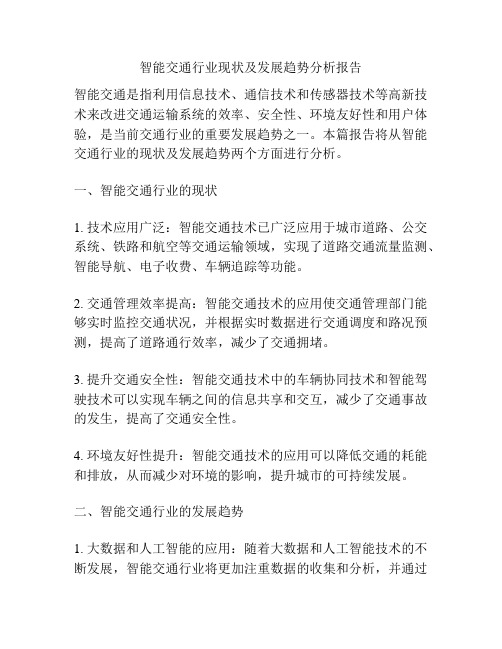
智能交通行业现状及发展趋势分析报告智能交通是指利用信息技术、通信技术和传感器技术等高新技术来改进交通运输系统的效率、安全性、环境友好性和用户体验,是当前交通行业的重要发展趋势之一。
本篇报告将从智能交通行业的现状及发展趋势两个方面进行分析。
一、智能交通行业的现状1. 技术应用广泛:智能交通技术已广泛应用于城市道路、公交系统、铁路和航空等交通运输领域,实现了道路交通流量监测、智能导航、电子收费、车辆追踪等功能。
2. 交通管理效率提高:智能交通技术的应用使交通管理部门能够实时监控交通状况,并根据实时数据进行交通调度和路况预测,提高了道路通行效率,减少了交通拥堵。
3. 提升交通安全性:智能交通技术中的车辆协同技术和智能驾驶技术可以实现车辆之间的信息共享和交互,减少了交通事故的发生,提高了交通安全性。
4. 环境友好性提升:智能交通技术的应用可以降低交通的耗能和排放,从而减少对环境的影响,提升城市的可持续发展。
二、智能交通行业的发展趋势1. 大数据和人工智能的应用:随着大数据和人工智能技术的不断发展,智能交通行业将更加注重数据的收集和分析,并通过人工智能算法实现智慧交通管理,提供更加个性化、智能化的交通服务。
2. 物联网技术的应用:物联网技术将进一步提升智能交通的效能和安全性,通过传感器和通信技术实现车辆、设备和路网等要素的实时监控和信息交互,为交通管理和用户提供精准的服务。
3. 5G技术的使用:5G技术的普及将使智能交通行业的发展迈上一个新台阶,以更低的延迟和更高的带宽,实现车联网、智能导航等更多场景的实时数据传输和交互。
4. 自动驾驶技术的发展:自动驾驶技术作为智能交通的重要支撑,将成为未来交通行业发展的重点领域。
自动驾驶技术的成熟将减少交通事故,提高交通效率,改变人们的出行方式。
5. 跨界合作与共享经济:智能交通行业需要各方的合作与共享,在政府、企业和社会各方面加强合作,推动智能交通行业的发展。
通过对智能交通行业的现状及发展趋势的分析,可以看出智能交通行业在技术应用广泛、交通管理效率提高、交通安全性及环境友好性提升等方面取得了显著成就。
智能交通技术的发展现状与未来趋势
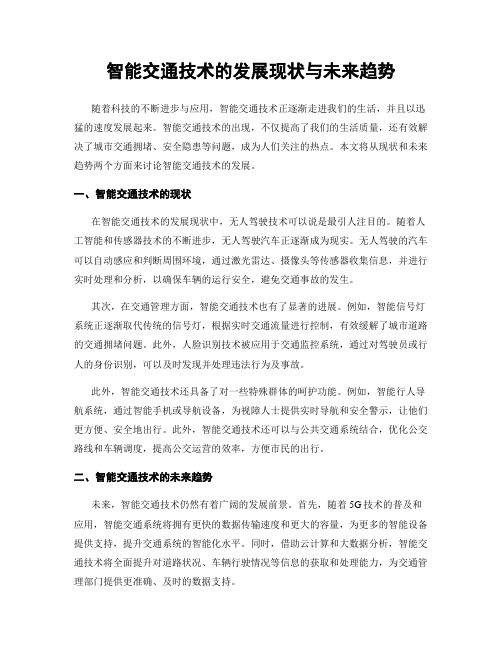
智能交通技术的发展现状与未来趋势随着科技的不断进步与应用,智能交通技术正逐渐走进我们的生活,并且以迅猛的速度发展起来。
智能交通技术的出现,不仅提高了我们的生活质量,还有效解决了城市交通拥堵、安全隐患等问题,成为人们关注的热点。
本文将从现状和未来趋势两个方面来讨论智能交通技术的发展。
一、智能交通技术的现状在智能交通技术的发展现状中,无人驾驶技术可以说是最引人注目的。
随着人工智能和传感器技术的不断进步,无人驾驶汽车正逐渐成为现实。
无人驾驶的汽车可以自动感应和判断周围环境,通过激光雷达、摄像头等传感器收集信息,并进行实时处理和分析,以确保车辆的运行安全,避免交通事故的发生。
其次,在交通管理方面,智能交通技术也有了显著的进展。
例如,智能信号灯系统正逐渐取代传统的信号灯,根据实时交通流量进行控制,有效缓解了城市道路的交通拥堵问题。
此外,人脸识别技术被应用于交通监控系统,通过对驾驶员或行人的身份识别,可以及时发现并处理违法行为及事故。
此外,智能交通技术还具备了对一些特殊群体的呵护功能。
例如,智能行人导航系统,通过智能手机或导航设备,为视障人士提供实时导航和安全警示,让他们更方便、安全地出行。
此外,智能交通技术还可以与公共交通系统结合,优化公交路线和车辆调度,提高公交运营的效率,方便市民的出行。
二、智能交通技术的未来趋势未来,智能交通技术仍然有着广阔的发展前景。
首先,随着5G技术的普及和应用,智能交通系统将拥有更快的数据传输速度和更大的容量,为更多的智能设备提供支持,提升交通系统的智能化水平。
同时,借助云计算和大数据分析,智能交通技术将全面提升对道路状况、车辆行驶情况等信息的获取和处理能力,为交通管理部门提供更准确、及时的数据支持。
其次,人工智能的快速发展将进一步推动智能交通技术的创新。
智能交通系统将更加智能化和自动化,通过学习和分析大量数据,能够更好地预测和应对交通拥堵、事故等问题。
例如,智能交通系统可以利用实时数据和算法来优化路线规划,避免拥堵区域,提高行驶效率。
智能交通行业的发展现状与未来展望

智能交通行业的发展现状与未来展望随着科技的不断进步和智能化技术的不断成熟,智能交通行业迅速崛起并取得了巨大的发展。
智能交通技术的应用给交通系统带来了许多创新和便利,同时也为城市的可持续发展提供了新的机遇。
本文将就智能交通行业目前的发展现状以及未来展望进行探讨。
一、智能交通行业的发展现状智能交通行业目前正处于快速发展的阶段,以下从几个方面介绍其发展现状。
1.1 智能交通基础设施建设智能交通基础设施建设是实现智能化交通系统的关键。
目前,许多城市已经开始投资兴建智能交通基础设施,包括智能交通信号灯、智能交通监控系统、智能停车系统等。
这些设施的部署可以提高道路交通的效率和安全性,减少交通事故的发生,并为城市居民提供更加便捷的出行体验。
1.2 智能交通数据的采集和处理智能交通系统可以通过各种传感器和监测设备采集大量交通数据,如交通流量、车速、拥堵情况等。
这些数据经过处理和分析后,可以帮助交通部门做出更加准确的交通规划和调度决策,提高交通的运行效率。
同时,这些数据也可以为交通参与者提供实时的交通信息,帮助他们优化出行路线和避免拥堵。
1.3 智能驾驶技术的发展智能驾驶技术是智能交通行业的重要组成部分。
目前,许多车辆制造商和科技公司正在研发自动驾驶技术,并取得了一定的突破。
自动驾驶技术的发展有望彻底改变交通系统和交通工具的运作方式,提高交通安全性和效率。
未来,我们有理由相信自动驾驶车辆将成为主流,人类驾驶可能会逐渐被取代。
二、智能交通行业的未来展望智能交通行业在未来的发展前景广阔,以下将就其未来展望进行探讨。
2.1 5G技术对智能交通的推动作用当前,5G技术正在不断发展和推广,其高速、低时延和大连接性的特点将对智能交通行业起到重要推动作用。
5G技术的应用可以实现交通设备与交通网络的无缝连接,提供更加精准和实时的数据采集、处理和传输服务,从而进一步提高交通系统的智能化水平。
2.2 人工智能技术的应用拓展随着人工智能技术的不断进步,其在智能交通行业的应用将更加广泛。
智能交通行业发展现状与未来趋势

智能交通行业发展现状与未来趋势近年来,随着科技的迅速发展和智能化水平的不断提升,智能交通行业逐渐成为人们生活中不可或缺的一部分。
智能交通技术的应用不仅提高了交通效率,还使交通安全得到极大的改善。
本文将就智能交通行业的发展现状以及未来的趋势进行探讨。
智能交通行业的发展现状智能交通行业的发展可以追溯到20世纪80年代,当时,交通问题日益突出,特别是大城市的交通压力巨大,交通事故频发。
于是各国开始加强对交通相关技术的研发,力求降低事故发生率、缓解交通压力。
经过几十年的发展,智能交通行业已经取得了显著的成果。
首先,智能交通技术的应用从传统的交通信号灯逐渐扩展到智能停车系统、智能交通管理平台等领域。
例如,现在的交通信号灯可以通过感应器自动调节时间,根据实时流量进行智能化调整,以提高交通效率。
其次,智能交通技术的应用也延伸到了车辆和驾驶员的管理上。
例如,智能车辆监控系统可以实时监控车辆的位置、速度等信息,及时提醒驾驶员注意安全。
智能驾驶辅助系统则可以通过感应器、摄像头等设备,帮助驾驶员预测潜在的交通事故,并进行相应的安全提示。
智能交通行业的未来趋势智能交通行业在未来将继续取得更大的突破和进步。
以下是智能交通行业未来的趋势之一:1. 人工智能技术的应用:随着人工智能技术的快速发展,智能交通行业将更多地应用人工智能技术,例如,利用深度学习算法对交通数据进行分析,预测交通流量及交通事故的发生概率,以便采取相应的调度措施。
2. 自动驾驶技术的进一步发展:自动驾驶技术将成为智能交通行业的重要发展方向。
目前,自动驾驶技术已经在一些特定场景中实现了应用,未来将进一步发展成为普及化的产业。
自动驾驶技术的应用将大大提高交通的安全性和效率。
3. 大数据分析的应用:随着各类传感器设备的大规模安装,智能交通行业将会产生海量的数据。
通过对这些数据进行分析和挖掘,可以发现交通问题的规律和特点,为交通管理部门提供决策支持。
结语智能交通行业的发展现状和未来趋势充满希望。
智能交通发展现状与未来趋势分析

智能交通发展现状与未来趋势分析智能交通是当今社会的一个热门话题,随着科技的飞速发展,人们对于交通系统的要求也越来越高。
智能交通系统以信息技术为基础,通过智能感知、智能决策和智能控制,实现交通流量优化、交通管理智能化和交通服务个性化等目标。
本文将探讨智能交通的发展现状以及未来的趋势。
首先,智能交通的发展现状已经取得了显著的成果。
以人工智能技术为代表的智能化技术已经应用于交通监控、信号灯控制、路况预测、智能导航等多个方面。
通过交通监控系统,交通部门能够实时监测并掌握交通流量状况,及时做出调度安排;通过智能信号灯控制技术,信号灯能够自主、智能地根据实时交通情况灵活设定信号时间,有效缓解交通阻塞;通过路况预测和智能导航系统,驾驶员可以及时获取道路信息和最佳路线,提高行车效率。
这些智能交通技术的应用,有效提升了交通系统的效率和安全性,给人们的出行带来了很大的便利。
其次,智能交通的未来趋势将更加多元化和智能化。
随着物联网和大数据技术的进一步发展,智能交通系统将与其他城市智能设施相互连接,形成智慧城市生态系统。
智能交通将会更加注重人性化的体验,通过大数据分析和个性化推荐算法,为居民提供智能出行服务,满足不同人群的出行需求。
比如,针对老年人、残疾人等特殊人群,智能交通系统可以提供更加人性化的交通服务,包括无障碍出行设施、定制化交通方案等。
同时,智能化技术在车辆与基础设施之间的通信将变得更加紧密,实现车联网和车路协同,降低交通事故风险。
此外,智能交通的发展离不开相关政策的引导和支持。
政府在智能交通规划、建设和监管等方面发挥着重要作用。
政府可以出台支持智能交通发展的政策和法规,为企业提供技术研发和示范应用的支持,推动智能交通技术的落地和推广。
同时,政府还应加强公众教育,提升居民对于智能交通的认知和接受度,提高整个社会的出行意识和道德素养。
综上所述,智能交通是未来交通发展的趋势,智能交通技术将深刻影响交通系统的运行方式与效率。
智能交通技术发展现状与未来趋势分析

智能交通技术发展现状与未来趋势分析随着科技的迅猛发展,智能交通技术逐渐成为了现代城市交通领域的热门话题。
智能交通技术的出现和应用,旨在提高交通效率、减少交通事故并改善出行体验。
本文将从智能交通技术的现状、应用和未来发展趋势三个方面进行分析。
一、智能交通技术现状在智能交通技术的现状方面,主要包括以下几个方面的进展:1. 无人驾驶技术的突破:无人驾驶技术是智能交通领域的一颗明星,许多科技巨头和汽车制造商都在进行无人驾驶技术的研发和应用。
无人驾驶技术的成熟将能够彻底改变交通系统,提高交通效率,减少交通事故。
2. 物联网在交通领域的应用:物联网通过连接各种感应器、设备和车辆,实现了车辆之间、车辆与交通设施之间的智能化交互。
这种物联网的应用能够实现车辆的自动检测、计算、决策和控制,提升交通系统的智能化水平。
3. 新型交通出行工具的涌现:共享经济带来了诸多新型交通出行工具,例如共享单车、电动滑板车和智能电动自行车等。
这些新型交通工具的出现,改变了传统的出行方式,使得城市出行更加便捷、环保和经济。
二、智能交通技术的应用智能交通技术的应用范围广泛,下面将从交通管理、交通安全和出行服务三个方面进行具体探讨:1. 交通管理:智能交通技术可以通过车辆识别、智能信号灯和智能高速公路等设备,对交通流量进行精确的监控和调控。
通过实时监控交通情况和分析数据,可以实现交通拥堵的迅速疏导和交通路径的优化。
2. 交通安全:智能交通技术在交通安全方面起到了积极作用。
通过视频监控和智能交通信号的协同工作,可以实现对交通违法行为的准确识别和自动处理。
同时,智能交通技术也可以为驾驶员提供实时的道路信息和驾驶建议,提高驾驶安全。
3. 出行服务:智能交通技术可以为出行者提供个性化的出行服务。
例如,通过智能导航系统,可以根据交通情况和能耗等因素规划最优出行路线;通过移动支付和在线预订,可以更加方便地使用公共交通工具和共享出行工具。
三、智能交通技术未来发展趋势在智能交通技术的未来发展趋势方面,主要包括以下几个方面:1. 联网交通系统:未来智能交通技术将更加注重交通系统的整体联网。
智能交通行业规划和发展趋势

智能交通行业规划和发展趋势随着科技的发展,智能交通正成为未来城市发展的重要方向之一。
智能交通无疑将为城市交通带来巨大的改变,为人们的出行提供更加高效、安全、环保的选择。
本文将从不同的角度探讨智能交通行业的规划和发展趋势。
一、智能交通的定义和意义智能交通是指以信息技术为基础,在交通运输系统中应用计算机、通信、传感、控制和导航等技术,提高交通系统的运行效率、交通安全性和行车舒适性的交通管理和服务系统。
智能交通的出现可以有效改善交通拥堵、提升交通安全、节约能源、减少环境污染等问题,对城市的可持续发展具有重要意义。
二、智能交通的发展现状目前,智能交通在全球范围内得到了广泛的应用。
各国纷纷加大对智能交通领域的投入,推动技术研发和应用。
在中国,智能交通也取得了长足的发展,包括智能交通信号灯、智能监控系统、智能交通管理平台等应用的推广和普及。
三、智能交通的关键技术要实现智能交通的发展,关键的技术是不可或缺的。
其中,人工智能、大数据、云计算、物联网等技术的应用是智能交通得以实现的基础。
人工智能技术可以通过学习和推理提高系统的智能化水平;大数据技术可以分析和挖掘交通数据,为交通决策提供支持;云计算技术可实现交通资源的共享和协同;物联网技术可以实现各种交通设备的互联互通。
四、智能交通管理与服务系统智能交通管理与服务系统是实现智能交通的核心内容,它包括交通信息收集、交通信息处理和交通决策支持三个方面。
交通信息收集通过各种传感器和监控设备获取交通信息;交通信息处理将收集到的交通信息进行处理和分析,形成交通数据;交通决策支持则通过对交通数据的分析和挖掘,提供优化的交通决策建议。
五、智能交通的应用场景智能交通的应用场景丰富多样。
例如,智能交通信号灯可以通过实时调控减少交通拥堵;智能公交系统可以实时调度公交车辆,提高公交运营效率;智能停车系统可以通过车辆识别和导航引导找到最合适的停车位;智能交通安防系统可以监控交通违法行为,加强交通管理和监管等。
智能交通系统的发展现状与未来前景

智能交通系统的发展现状与未来前景智能交通系统(Intelligent Transportation System, ITS)作为现代城市交通管理的重要手段,正日益受到全球范围内的关注和投资。
其将信息技术和传统交通管理相结合,旨在提高交通效率、降低交通事故率、改善出行体验和减少环境污染。
本文将重点探讨智能交通系统的发展现状和未来前景。
一、发展现状1.1 数据收集和处理能力的提升随着传感器技术的不断发展和部署,交通数据的收集与处理能力大幅度提升。
现在,交通系统可以实时获取道路流量、车辆速度、停车情况等信息,并通过数据分析进行智能化的交通管理。
1.2 信号灯优化与控制智能交通系统通过优化信号灯控制,可以根据道路流量和车辆需求进行灵活调整,以减少交通堵塞和排队时间。
这项技术的应用已经在许多城市得到验证,并取得了显著的效果。
1.3 车辆自动驾驶技术的突破车辆自动驾驶是智能交通系统的重要组成部分。
近年来,自动驾驶技术取得了许多突破,例如自适应巡航控制、自动泊车和交通拥堵时的自动驾驶等。
这些技术的发展为未来交通系统的智能化提供了可靠的基础。
二、未来前景2.1 智能交通系统的深入应用随着技术的进一步发展和成本的降低,智能交通系统将在更广泛的范围内应用。
除了现有的信号灯优化和车辆自动驾驶外,智能公交系统、智能出租车调度和共享交通等系统也将逐渐成熟并得到推广。
2.2 人工智能的应用人工智能在智能交通系统中的应用也是未来的发展方向。
通过深度学习和模式识别,人工智能可以实现对交通信息的准确识别和预测,提供更加精准的交通控制和优化策略。
2.3 交通系统与城市管理的整合随着城市化进程的加快,交通系统与城市管理的整合成为未来的趋势。
智能交通系统的发展将与城市规划、住房规划和市政基础设施建设相互融合,提升城市的整体运行效率。
2.4 环境友好型交通系统的实现未来的智能交通系统将更加注重可持续发展和环境友好型。
通过优化交通流动性和减少拥堵,智能交通系统可以降低交通排放和噪音污染,为城市提供更清洁、更宜居的环境。
智能交通的现状与未来发展方向
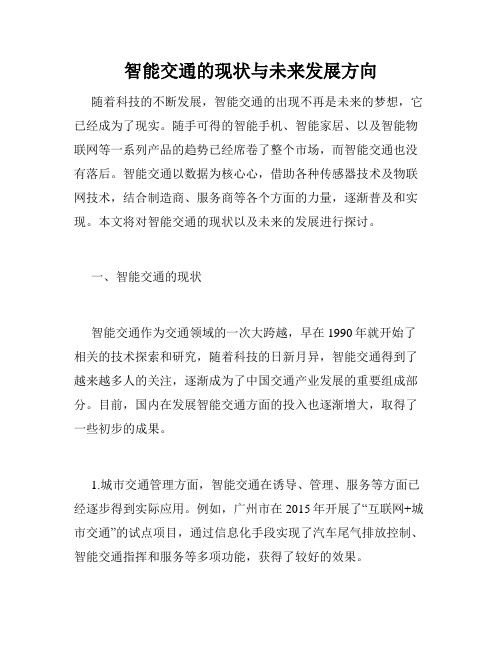
智能交通的现状与未来发展方向随着科技的不断发展,智能交通的出现不再是未来的梦想,它已经成为了现实。
随手可得的智能手机、智能家居、以及智能物联网等一系列产品的趋势已经席卷了整个市场,而智能交通也没有落后。
智能交通以数据为核心心,借助各种传感器技术及物联网技术,结合制造商、服务商等各个方面的力量,逐渐普及和实现。
本文将对智能交通的现状以及未来的发展进行探讨。
一、智能交通的现状智能交通作为交通领域的一次大跨越,早在1990年就开始了相关的技术探索和研究,随着科技的日新月异,智能交通得到了越来越多人的关注,逐渐成为了中国交通产业发展的重要组成部分。
目前,国内在发展智能交通方面的投入也逐渐增大,取得了一些初步的成果。
1.城市交通管理方面,智能交通在诱导、管理、服务等方面已经逐步得到实际应用。
例如,广州市在2015年开展了“互联网+城市交通”的试点项目,通过信息化手段实现了汽车尾气排放控制、智能交通指挥和服务等多项功能,获得了较好的效果。
2.智能交通技术的应用,例如车联网技术,手机 App 等,使出行方式更为智慧化。
目前,一些国内汽车企业已经推出了配备车联网技术的车型,提供了智能导航、智能驾驶、车载 Wi-Fi 等一些高级功能,带来了更为智能的驾驶体验。
3.公共交通方面,一些城市已经开始尝试用人工智能技术来掌控公交运行规划,实现车辆调度、交通决策等,以优化公共交通资源的配置,提升城市交通系统的整体效率。
二、智能交通的未来发展方向未来,随着政府、企业及用户需求的变化,智能交通也会逐渐向着更加广泛的领域发展。
下面将重点介绍一下未来智能交通的发展方向。
1.把智能公交从内部向外扩展在未来,智能公交不仅仅是半自动驾驶或全自动驾驶,而是需要向外拓展。
例如,可以在公交站点设置大屏幕显示预测发车时间和实际发车时间,让用户及时了解到公交车实际运行状态,规避了用户可能的等候时间,提升了用户整体满意度。
2.多场景智能交通的发展未来,智能交通不再仅仅是围绕着汽车行驶进行开发,而是需要结合交通领域的多样性场景进行创新。
智能交通系统的发展现状与未来走向
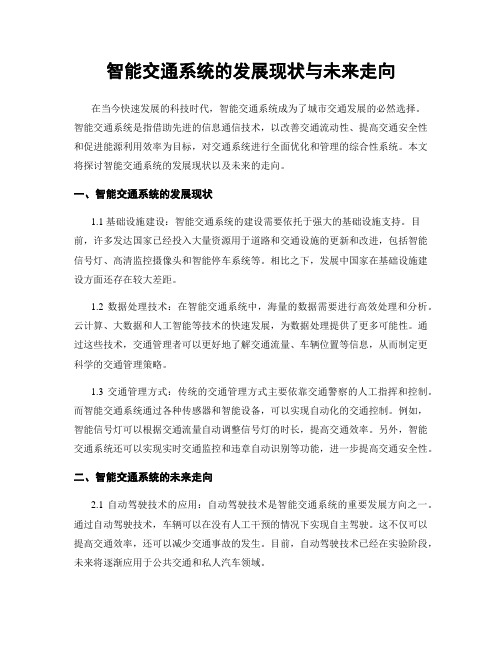
智能交通系统的发展现状与未来走向在当今快速发展的科技时代,智能交通系统成为了城市交通发展的必然选择。
智能交通系统是指借助先进的信息通信技术,以改善交通流动性、提高交通安全性和促进能源利用效率为目标,对交通系统进行全面优化和管理的综合性系统。
本文将探讨智能交通系统的发展现状以及未来的走向。
一、智能交通系统的发展现状1.1 基础设施建设:智能交通系统的建设需要依托于强大的基础设施支持。
目前,许多发达国家已经投入大量资源用于道路和交通设施的更新和改进,包括智能信号灯、高清监控摄像头和智能停车系统等。
相比之下,发展中国家在基础设施建设方面还存在较大差距。
1.2 数据处理技术:在智能交通系统中,海量的数据需要进行高效处理和分析。
云计算、大数据和人工智能等技术的快速发展,为数据处理提供了更多可能性。
通过这些技术,交通管理者可以更好地了解交通流量、车辆位置等信息,从而制定更科学的交通管理策略。
1.3 交通管理方式:传统的交通管理方式主要依靠交通警察的人工指挥和控制。
而智能交通系统通过各种传感器和智能设备,可以实现自动化的交通控制。
例如,智能信号灯可以根据交通流量自动调整信号灯的时长,提高交通效率。
另外,智能交通系统还可以实现实时交通监控和违章自动识别等功能,进一步提高交通安全性。
二、智能交通系统的未来走向2.1 自动驾驶技术的应用:自动驾驶技术是智能交通系统的重要发展方向之一。
通过自动驾驶技术,车辆可以在没有人工干预的情况下实现自主驾驶。
这不仅可以提高交通效率,还可以减少交通事故的发生。
目前,自动驾驶技术已经在实验阶段,未来将逐渐应用于公共交通和私人汽车领域。
2.2 联网交通系统:随着物联网技术的发展,交通设施将可以互相联网,实现信息的共享和传递。
通过联网交通系统,交通设施可以实时传输数据,交通管理者可以更准确地了解交通状况。
此外,联网交通系统还可以通过智能导航、车辆跟踪等功能,提供更便利的出行服务。
2.3 绿色出行的推动:智能交通系统的发展也与环保出行密切相关。
智能交通技术的发展现状与未来趋势分析

智能交通技术的发展现状与未来趋势分析近年来,随着科技的飞速发展,智能交通技术逐渐成为改善人们出行体验、提高交通效率的重要手段。
智能交通技术以其高效、便捷的特点受到越来越多人的关注和追捧。
本文将从发展现状和未来趋势两个方面进行分析,以期展望智能交通技术在未来的发展。
首先,让我们来了解一下智能交通技术的发展现状。
目前,智能交通技术已经广泛应用于城市的交通管理中。
例如,交通信号灯的智能化管理可以根据实时交通流量和方向进行自适应调整,使交通流更加畅通;智能停车系统通过感应器和传感器掌握停车位的占用情况,提供精确的停车导引,解决了停车难题;智能公交系统能够通过GPS定位和实时调度,准确预估公交车到站时间,方便乘客及时乘坐;智能监控系统利用摄像头和人工智能技术,及时监测交通违法行为,维护道路秩序等等。
智能交通技术的发展离不开科技的支持。
随着人工智能、大数据、云计算等技术的快速发展,智能交通技术在应用上有了更多可能。
例如,利用人工智能技术,交通信号灯系统可以根据交通流量、路况、天气等信息进行智能调度,实现更加高效的信号控制;利用大数据分析,交通管理部门可以实时监测交通拥堵情况,及时采取措施疏导交通;利用云计算,不同城市之间的交通信息可以进行实时共享,提高交通整体运行效率。
然而,智能交通技术目前面临着一些挑战。
首先,技术成本较高是智能交通技术发展的一大阻碍。
许多新兴技术需要高昂的研发和运营成本,限制了其在更多地区的应用。
其次,隐私安全问题也是智能交通技术发展的一个重要考量因素。
智能交通技术需要收集和处理大量的个人数据,如果隐私安全措施不到位,将给个人隐私带来风险。
此外,对于用户而言,技术的复杂性和使用的便捷性也是一个需要平衡的问题。
那么,未来智能交通技术的发展将呈现怎样的趋势呢?首先,智能交通技术将向更加智能化、个性化发展。
通过不断深化人工智能和大数据技术的应用,智能交通系统将更加准确地判断和预测交通状况,针对不同用户提供个性化的交通出行方案。
智能交通的发展现状和未来趋势
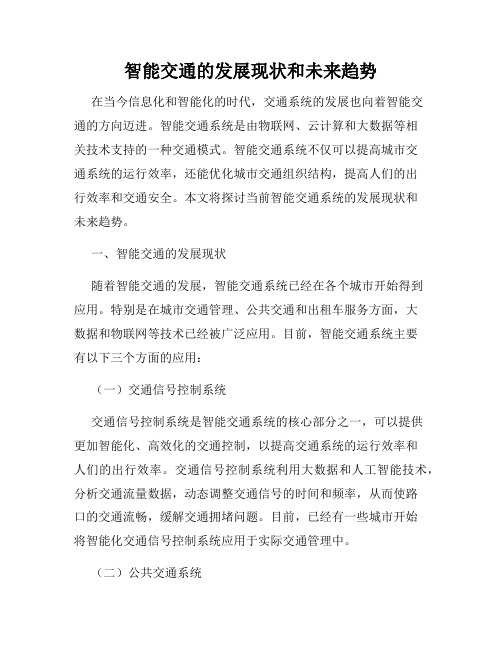
智能交通的发展现状和未来趋势在当今信息化和智能化的时代,交通系统的发展也向着智能交通的方向迈进。
智能交通系统是由物联网、云计算和大数据等相关技术支持的一种交通模式。
智能交通系统不仅可以提高城市交通系统的运行效率,还能优化城市交通组织结构,提高人们的出行效率和交通安全。
本文将探讨当前智能交通系统的发展现状和未来趋势。
一、智能交通的发展现状随着智能交通的发展,智能交通系统已经在各个城市开始得到应用。
特别是在城市交通管理、公共交通和出租车服务方面,大数据和物联网等技术已经被广泛应用。
目前,智能交通系统主要有以下三个方面的应用:(一)交通信号控制系统交通信号控制系统是智能交通系统的核心部分之一,可以提供更加智能化、高效化的交通控制,以提高交通系统的运行效率和人们的出行效率。
交通信号控制系统利用大数据和人工智能技术,分析交通流量数据,动态调整交通信号的时间和频率,从而使路口的交通流畅,缓解交通拥堵问题。
目前,已经有一些城市开始将智能化交通信号控制系统应用于实际交通管理中。
(二)公共交通系统公共交通系统是城市交通系统中最重要的组成部分之一,也是最需要智能化升级的部分之一。
智能公共交通系统可以通过GPS 和其他传感器等技术,实时监控公交车的运行状态和公交车站点的人流量,从而解决公交车晚点、拥堵等问题。
此外,智能公共交通系统还可以为乘客提供更加便捷的乘车服务,包括实时公交车到站时间、公交车运行路线等方面的信息。
(三)出租车服务智能出租车服务可以通过大数据分析和GPS等技术,预测出租车服务需求,提高出租车服务的响应速度和效率。
此外,智能出租车服务还可以通过数据挖掘技术,分析出租车服务的优劣,为出租车服务提供更加优质的服务。
二、智能交通的未来趋势智能交通的发展前景非常广阔,未来的智能交通系统将会越来越智能化、高效化、安全化和人性化。
以下是智能交通未来发展的几个趋势:(一)智能化交通信号控制系统未来智能化交通信号控制系统将会更加智能化、高效化和可持续化。
2024年智能交通市场发展现状
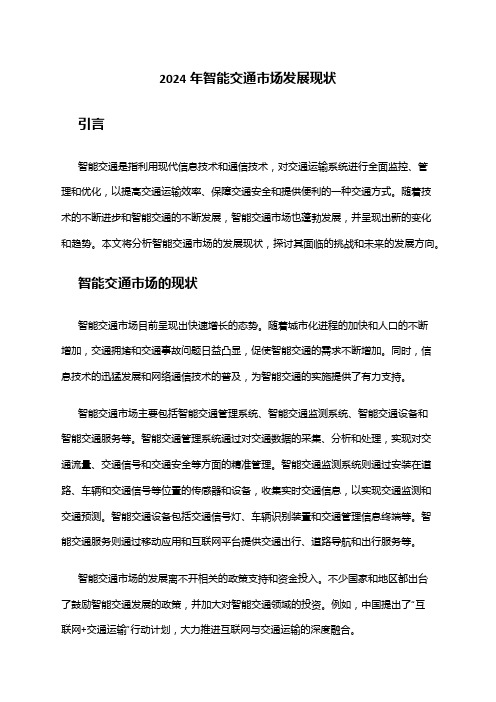
2024年智能交通市场发展现状引言智能交通是指利用现代信息技术和通信技术,对交通运输系统进行全面监控、管理和优化,以提高交通运输效率、保障交通安全和提供便利的一种交通方式。
随着技术的不断进步和智能交通的不断发展,智能交通市场也蓬勃发展,并呈现出新的变化和趋势。
本文将分析智能交通市场的发展现状,探讨其面临的挑战和未来的发展方向。
智能交通市场的现状智能交通市场目前呈现出快速增长的态势。
随着城市化进程的加快和人口的不断增加,交通拥堵和交通事故问题日益凸显,促使智能交通的需求不断增加。
同时,信息技术的迅猛发展和网络通信技术的普及,为智能交通的实施提供了有力支持。
智能交通市场主要包括智能交通管理系统、智能交通监测系统、智能交通设备和智能交通服务等。
智能交通管理系统通过对交通数据的采集、分析和处理,实现对交通流量、交通信号和交通安全等方面的精准管理。
智能交通监测系统则通过安装在道路、车辆和交通信号等位置的传感器和设备,收集实时交通信息,以实现交通监测和交通预测。
智能交通设备包括交通信号灯、车辆识别装置和交通管理信息终端等。
智能交通服务则通过移动应用和互联网平台提供交通出行、道路导航和出行服务等。
智能交通市场的发展离不开相关的政策支持和资金投入。
不少国家和地区都出台了鼓励智能交通发展的政策,并加大对智能交通领域的投资。
例如,中国提出了“互联网+交通运输”行动计划,大力推进互联网与交通运输的深度融合。
智能交通市场上的主要参与者包括政府部门、交通管理机构、信息技术公司、智能交通设备厂商和交通运输企业等。
政府部门和交通管理机构负责制定政策和规划,推动智能交通的实施和发展。
信息技术公司提供技术支持和解决方案,智能交通设备厂商负责生产和销售相关设备,交通运输企业则是智能交通系统的使用者和服务提供者。
智能交通市场面临的挑战虽然智能交通市场呈现出快速增长的态势,但仍然面临一些挑战。
首先,智能交通技术的标准化和统一仍然是一个亟待解决的问题。
智能交通的发展现状与未来趋势分析

智能交通的发展现状与未来趋势分析智能交通是指利用计算机、通信、传感器等先进技术,对交通系统进行智能化改造,提供更高效、更安全、更环保的交通服务。
随着人工智能和物联网技术的不断发展,智能交通正在成为城市发展重点领域之一。
本文将从智能交通的发展现状和未来趋势两个方面进行探讨。
一、智能交通的发展现状目前,智能交通已经在许多城市得到了广泛应用。
首先是交通信号灯的智能化。
通过安装智能化的交通信号灯,可以根据交通流量的变化自动调整信号灯的时长,提高交通效率,缓解拥堵。
同时,交通信号灯还可以通过实时监测路面情况,提前发现故障,并及时通知维护人员进行处理,提高交通信号灯的稳定性和可靠性。
其次是智能交通管理系统的建设。
智能交通管理系统通过整合各类信息,包括交通流量、车辆定位、违规行为等,通过数据分析和智能算法,对道路交通进行实时监测和管理,及时调度交通资源,提高路网的通行能力和交通安全。
另外,智能驾驶技术也是智能交通发展的重要方向。
目前,自动驾驶汽车已经进入实际应用阶段。
自动驾驶技术的发展,将彻底改变人们出行的方式。
通过激光雷达、摄像头、传感器等设备,自动驾驶汽车可以实时感知周围环境,自动规划最优路径,并实现无人驾驶的功能。
这不仅能够提高交通安全性,还能够减少交通事故,节约能源,改善交通效率。
二、智能交通的未来趋势随着人工智能和物联网的进一步发展,智能交通的未来将呈现出以下几个趋势。
首先,智能交通将更加注重环境友好型。
随着全球环保意识的提高,智能交通将更加注重降低车辆尾气排放。
智能交通系统将通过智能算法和数据分析,优化路线规划和调度策略,减少车辆的行驶距离和时间,降低交通拥堵,从而减少尾气排放。
其次,智能交通将实现更深度的智能化。
随着人工智能技术的不断发展,交通管理系统将更加智能化。
通过人工智能技术,交通管理系统可以更加准确地识别交通违规行为,并及时对违规车辆进行处理,提高交通安全性。
此外,智能交通还将与智能家居、智能城市等领域进行深度融合,实现更高效的城市管理和服务。
智能交通发展的现状和趋势
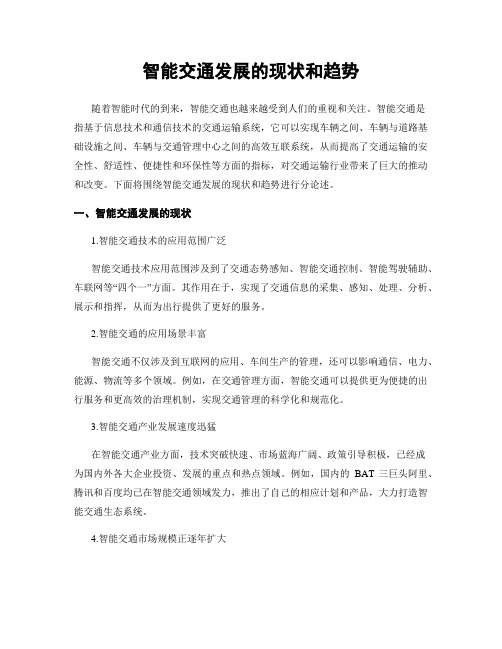
智能交通发展的现状和趋势随着智能时代的到来,智能交通也越来越受到人们的重视和关注。
智能交通是指基于信息技术和通信技术的交通运输系统,它可以实现车辆之间、车辆与道路基础设施之间、车辆与交通管理中心之间的高效互联系统,从而提高了交通运输的安全性、舒适性、便捷性和环保性等方面的指标,对交通运输行业带来了巨大的推动和改变。
下面将围绕智能交通发展的现状和趋势进行分论述。
一、智能交通发展的现状1.智能交通技术的应用范围广泛智能交通技术应用范围涉及到了交通态势感知、智能交通控制、智能驾驶辅助、车联网等“四个一”方面。
其作用在于,实现了交通信息的采集、感知、处理、分析、展示和指挥,从而为出行提供了更好的服务。
2.智能交通的应用场景丰富智能交通不仅涉及到互联网的应用、车间生产的管理,还可以影响通信、电力、能源、物流等多个领域。
例如,在交通管理方面,智能交通可以提供更为便捷的出行服务和更高效的治理机制,实现交通管理的科学化和规范化。
3.智能交通产业发展速度迅猛在智能交通产业方面,技术突破快速、市场蓝海广阔、政策引导积极,已经成为国内外各大企业投资、发展的重点和热点领域。
例如,国内的BAT三巨头阿里、腾讯和百度均已在智能交通领域发力,推出了自己的相应计划和产品,大力打造智能交通生态系统。
4.智能交通市场规模正逐年扩大智能交通市场规模不断扩大,预计未来5年的市场规模将逐年增加。
据相关统计数据显示,美国、日本、中国等国家的智能交通市场规模已经达到了千亿级别,其中,中国的市场增速尤其显著,将会成为未来继续快速增长的主要驱动力。
二、智能交通发展的趋势1.智能交通将进一步加速车路协同发展的步伐在智能交通发展的未来,车路协同的发展将会越来越快。
未来,道路建设将逐步承担起数据采集和信息传递的功能,实现更为智能化的路网管理,不断提高道路的通行性、安全性和环保性。
2.智能交通将成为城市发展的重要引擎智能交通可以为城市提供更为便捷的出行方式和更加高效的城市交通系统。
智能交通技术的发展现状与未来展望

智能交通技术的发展现状与未来展望智能交通技术,作为一种将信息技术和通信技术应用于交通管理与服务的技术手段,正逐渐改变着我们的出行方式和城市运行模式。
随着人工智能、物联网和大数据等技术的迅猛发展,智能交通技术正日益成为现代城市交通领域中的热门话题。
首先,我们来看一下智能交通技术的发展现状。
目前,智能交通已经在城市交通中得到广泛应用。
交通信号系统的智能化是其中的重要方面之一。
通过传感器和智能算法,信号灯可以根据实时路况自动调节红绿灯的时长,从而优化路口的交通流量,缓解拥堵问题。
另外,智能导航系统和GPS导航系统的结合也使得驾驶导航更加准确和高效。
同时,智能交通技术也在自动驾驶领域有所突破。
自动驾驶车辆配备了多种传感器和人工智能系统,可以通过感知周围环境、判断交通情况并做出相应的行驶决策。
虽然目前自动驾驶汽车仍处于试验阶段,但已经在一些特定场景下取得了一定的突破,为未来实现全面自动驾驶奠定了基础。
除此之外,智能交通技术的未来展望仍然充满挑战和机遇。
首先是智能交通系统的整合方面。
目前,各大城市的交通管理系统大多还存在信息孤岛的问题,缺乏良好的信息共享机制。
未来,建立智能交通系统的整合平台,将不同区域、不同城市的交通数据进行整合和共享,可以更好地优化整个交通网络,实现全局最优。
其次,智能交通技术的应用范围还可以进一步扩展。
除了传统的交通工具,如汽车、公交车等,未来智能交通技术还可以应用于共享单车、电动车、无人机等新兴交通工具。
通过实时定位和智能调度,可以更加高效地管理和服务这些交通工具。
此外,随着5G技术的发展,智能交通技术也将迎来更多的创新机遇。
5G技术可以提供更低的时延和更高的带宽,为实时数据传输提供了更好的支持。
基于5G技术,智能交通系统可以更加准确地感知路况和交通情况,实现更高效的交通管理和服务。
然而,在智能交通技术的发展过程中,也还存在一些问题需要解决。
首先是数据隐私和安全问题。
智能交通系统依赖于大量的数据收集和处理,因此数据的安全性和隐私保护变得尤为重要。
智能交通系统的发展现状与趋势

智能交通系统的发展现状与趋势在当今社会,随着城市化进程的加速和人们出行需求的不断增长,交通拥堵、交通安全等问题日益凸显。
为了解决这些难题,智能交通系统应运而生,并在近年来取得了显著的发展。
智能交通系统是将先进的信息技术、数据通讯传输技术、电子传感技术、控制技术及计算机技术等有效地集成运用于整个地面交通管理系统而建立的一种在大范围内、全方位发挥作用的,实时、准确、高效的综合交通运输管理系统。
一、智能交通系统的发展现状1、智能交通基础设施不断完善在道路方面,越来越多的城市开始建设智能道路,通过在道路上安装传感器、摄像头等设备,实时收集交通流量、车速、路况等信息。
在交通信号控制方面,智能交通信号系统得到了广泛应用,能够根据实时交通流量自动调整信号灯的时长,提高道路通行效率。
2、车辆智能化程度逐步提高自动驾驶技术是当前车辆智能化的热门研究领域。
目前,自动驾驶技术已经从实验室走向了实际道路测试阶段,部分汽车制造商已经推出了具备一定自动驾驶功能的汽车。
此外,车辆的智能化还体现在车辆的安全性能提升上,如自动紧急制动、自适应巡航控制等功能的普及。
3、出行服务智能化随着智能手机的普及,各种出行类 APP 层出不穷。
这些 APP 可以为用户提供实时的公交、地铁、出租车等出行信息,帮助用户规划最优出行路线。
同时,共享出行模式如共享单车、共享汽车等也在一定程度上改变了人们的出行方式,提高了交通资源的利用率。
4、交通管理智能化交通管理部门通过大数据分析、人工智能等技术手段,对交通数据进行深入挖掘和分析,实现了对交通拥堵的精准预测和及时处置。
此外,智能交通执法系统也得到了广泛应用,如电子警察、高清卡口等,提高了交通执法的效率和准确性。
二、智能交通系统发展面临的挑战1、技术难题虽然智能交通系统在技术上取得了一定的突破,但仍面临着一些技术难题。
例如,自动驾驶技术在复杂的交通环境下的可靠性和安全性仍有待提高;智能交通系统中的数据传输和处理速度还需要进一步加快,以满足实时性的要求。
- 1、下载文档前请自行甄别文档内容的完整性,平台不提供额外的编辑、内容补充、找答案等附加服务。
- 2、"仅部分预览"的文档,不可在线预览部分如存在完整性等问题,可反馈申请退款(可完整预览的文档不适用该条件!)。
- 3、如文档侵犯您的权益,请联系客服反馈,我们会尽快为您处理(人工客服工作时间:9:00-18:30)。
More sophisticated forecasting can include other aspects of traveler decisions, including auto ownership, trip chaining (the decision to link individual trips together in a tour) and the choice of residential or business location (known as land use forecasting). Transportation engineering, as practiced by civil engineers, primarily involves planning, design, construction, maintenance, and operation of transportatio8
▪ Congestion reduces efficiency of transportation infrastructure and increases travel time, air pollution, and fuel consumption.
▪ "Road operators, infrastructure, vehicles, their drivers and other road users will cooperate to deliver the most efficient, safe, secure and comfortable journey. The vehicle-vehicle and vehicle-infrastructure co-operative systems will contribute to these objectives beyond the improvements achievable with stand-alone systems."
What is ITS?
▪ 智慧型運輸系統 (ITS, Intelligent Transportation System)乃是應 用先進的電子、通信、資訊與感測等技術, 以整合人、路、車的管理策略,提供即時 (real-time)資訊以增進運輸系統的安全、效率 及舒適性,同時也減少交通對環境的衝擊。
Operations and management involve traffic engineering, so that vehicles move smoothly on the road or track. Older techniques include signs, signals, markings, and tolling. Newer technologies involve intelligent transportation systems (ITS), including advanced traveler information systems (such as variable message signs), advanced traffic control systems (such as ramp meters), and vehicle infrastructure integration.
ITS (Intelligent transportation system)
• ITS refers to efforts to add information and communications technology to transport infrastructure and vehicles in an effort to manage factors that typically are at odds (不一致) with each other, such as vehicles, loads, and routes to improve safety and reduce vehicle wear, transportation times, and fuel consumption.
• ITS comes from the problems caused by traffic congestion(擁塞) and a synergy(協同增效作用) of new information technology for simulation, real-time control, and communications networks.
Technical forecasting of passenger travel usually involves an urban transportation planning model, requiring the estimation of trip generation (how many trips for what purpose), trip distribution (destination choice, where is the traveler going), mode choice (what mode is being taken), and route assignment (which streets or routes are being used).
Introduction
▪ The planning aspects of transport engineering relate to urban planning, and involve technical forecasting decisions and political factors.
